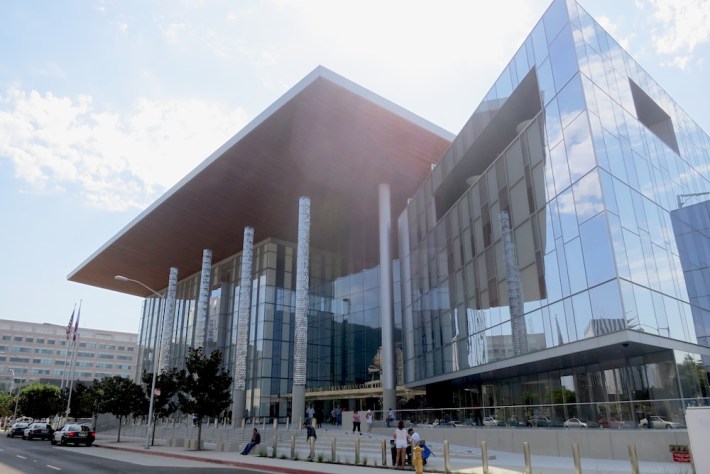Amidst much brouhaha last week, the Governor George Deukmejian Courthouse opened in Long Beach, formally replacing the dilapidated mid-mod 1958 courthouse on Ocean Boulevard.
People are—rightfully so to an extent—quite happy: it looks more like an art museum than a place to face criminal activity. And even more, the project was a much-touted public-private partnership (P3)—basically a single contract between a private firm and the government—for the cool cost of $395M.
Then why would a nonpartisan fiscal and policy advisor, the Legislative Analyst's Office of California, release a report stating that the actual cost is $490M? And are P3s not as bright and shiny as they appear to be—and more importantly, pillage our wallets instead of saving us a little bit?
According to an article in The Recorder which referenced the report, "The Administrative Office of the Courts (AOC) used skewed assumptions to justify building the new Long Beach courthouse under an untested public-private financing scheme."Last I checked, "skewed assumptions" and "financing schemes" are not the best way to describe one of the state's two largest P3 projects, with the other being San Francisco's Presidio Parkway Transportation Project by Caltrans. And the report is no less minced in its wording: it indicates that AOC and Caltrans have not aligned their projects with the best P3 practices that research has indicated, including transparency and castigating other procurement options—such as a design-bid-build approach—in such a bad light that a P3 approach was perpetually favored.
As stated on the site of the Judicial Branch of California, the private company must "cover all risks related to design and construction–such as any additional work needed to pass building code agency reviews and receive permits, any costs related to construction delays, and even latent defects in the architectural or engineering design."
Put simply: a private firm designs and builds it while receiving a yearly state fee to manage it. In direct numbers, that amounts to a 35-year lease to the private firm with the state handing over a staggering $2.3B in return over the course of the lease if inflation continues at the rate it is currently at.
This isn't to mention the cost that the City of Long Beach will be shouldering to transfer inmates via van since it will no longer have a tunnel connecting the Police Department to the new courthouse. That is going to cost $279,000 to start up and a current-day cost of $243,000 per year to operate.
The additional costs for transferring inmates is nothing new: 5th District Councilmember Gerrie Schipske brought up the fact that a tunnel should have been put into the original bid back in autumn of 2011. On October 4 of that year, Councilmembers Gary DeLong, Robert Garcia, Patrick O'Donnell and Dee Andrews supported the city paying $1 million in start-up costs for the tunnel (which was estimated by the City to cost somewhere between $7M and $10M).
The report goes onto state a very basic point: California taxpayers have overpaid for two infrastructure projects—risks that Susan Fainstein pointed out in 2008 when she noted that P3s all have "a striking physical similarity among the schemes and also a convergence embodied in private-sector involvement and market orientation." In more succinct terms: a market-led approach to city planning that has led to disaster is some places, most prominently the Ørestad project in Copenhagen.
So what are we to precisely do when we need massive, essential infrastructure upgrades—the new courthouse is expected to be able to handle tens of thousands of more people per month in addition to streamlining processes—but face dire economic constraints?
The LAO report suggests not abandoning the idea entirely but codifying four major alterations through the legislature: One, write into state law specific criteria surrounding P3 project selections; two, require comparisons to other procurement options; three, require the Public Infrastructure Advisory Commission to approve state P3 projects rather than entities like the AOC or Caltrans; and lastly, require the aforementioned commission to hire and use experts in P3, state finance and procurement, while continuing to develop research that would expand the best practices possible for P3 projects.
This not only seems logical, but essential. So only one question remains: Why aren't we talking about this?







